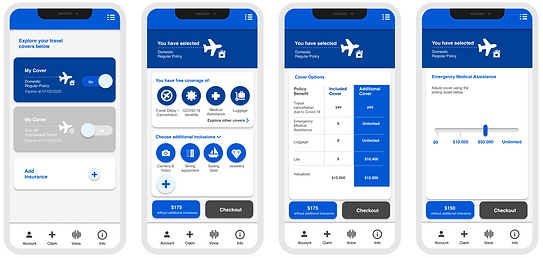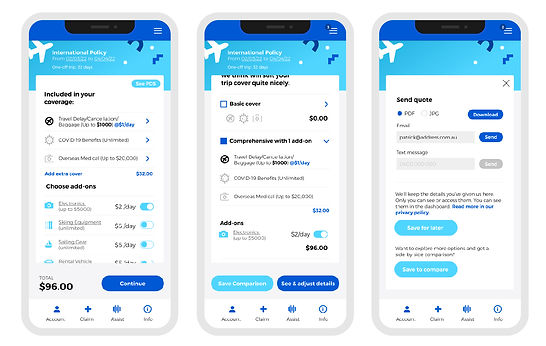
WORKING WITH NAKED AMBITION: A NEW INSURANCE EXPERIENCE
Naked Ambition was originally approached to run a discovery sprint by their client (a medium-sized, well-loved financial institution) over an 8 week period to establish the viability of a new insurance product and in which space they should look into playing.
I jumped onto the project after this initial research phase was completed with the aim to help take the insights gained into the next phases of definition, development and delivery. Our scope included several sprints in the lead up to creating a Path to MVP playbook with a tested set of key experiences, product integration recommendations based around a solid Business Model Canvas set out in the discovery stage.
Role: Innovation Designer
Credits: Chief Innovation Officer: Olga Cuesta / Founder & CEO: Fiona Triaca / Senior Service Designer: Erin Tan / UX Designer & Facilitator: Killian Poolmans / Innovation Strategist: Fred Etiemble
Initial discovery
This work was completed in the initial discovery stage that I wasn't a part of.
The initial discovery found customers leaning towards a combination of travel and valuables insurance with potentially more research to be done in the life insurance sector. Travel and valuables are where we spent the most time digging into the potential product experience.
There were 4 main insights that were gained from a series of contextual interviews and a benchmark trends analysis:
1.
Understanding value: Insurance is overly complex and it's hard for users to know where value can be found
Customers sense that insurance is designed for the use of the insurer and not the user, to bring value we needed to challenge the elements of function to serve a win-win strategy.
2.
Decision making:
Helping users navigate the complexity of insurance via the speed of trust
Customers do not understand how insurance should work or the right steps to take and consider before buying cover and then claiming as a result.
3.
Building knowledge with trust:
Empowering users with information they can trust to make good decisions
Opportunity: To play the role of a trusted expert by also guiding customers to understand what they should get covered for
4.
Finding the balance:
Endow users with peace of mind around coverage and cost
When customers buy insurance, they are paying for something that they hope to never use. They are guided by a given possible future scenario of something that "might" happen.
2nd Ideation Process

Where I jumped in
1st Ideation Process
Behavioral Science analysis & recommendation
4 x user testing + iteration rounds
Business Canvas Model Development
Playbook delivery
My proposed approach:
I presented my proposed approach to the team on tackling the work ahead.




1st Ideation to 2nd Ideation and the things in between
Working with the initial insights and prototype visuals from the discovery/research phase, my workmate Killian and I conducted an ideation workshop with our client and some team mates over a couple of sessions to get our heads around the project, and find out where our client wanted to start the problem-solving process.
Initial prototype screens (4 of 24)

1st Ideation Process
Where do we want to be in 5 years with this product?
How might we do that?
Lightening demos
Sketch/describe the solutions then vote
Build on each other's ideas
Ideas/brain dump
Consolidate, create concept cards as high level prototypes
Identify assumptions and prioritise key assumptions colaboratively
Create questions based on assumptions
Create test plan with hypotheses & verification measures
Create storyboards based on problem-realisation-features- outcome-
Then we tested & iterated
Artefacts created during this process

Spine features gaps analysis + HMWs for Ideation Session 2
2nd Ideation Process
From the spine features each of the gaps are identified
How might we fill each gap based on the values?
Lightening demos
Sketch/describe the solutions then vote
Build on each other's ideas
Ideas/brain dump
Consolidate patterns in upvoted ideas
Using value-based vs resource scale, evaluate concepts
Create lo-fi sketches of wireframes
Create test plan with hypotheses & verification measures
Create med-fi prototypes for testing
Tested 5 concepts
High fidelity prototype screens (10 of 55)



Other artefacts created during this process

Analogous + competitor research board

Visual timeline for stakeholders

Interview synthesis, journey map + user stories
